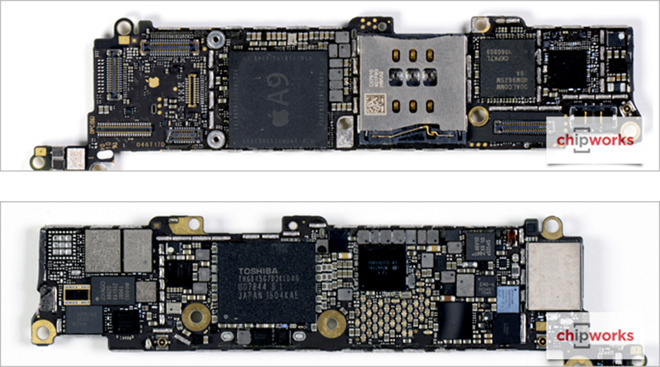In spite of recyling many parts from other iPhones, Apple's profit margin on the iPhone SE is relatively low next to the high-end iPhone 6s, a new analyst estimate suggests.
Based on a recent Chipworks teardown, Apple's bill of materials is probably about $260, RBC Capital Markets analyst Amit Daryanani argued in a memo obtained by AppleInsider. Given an entry retail cost of $399, that would indicate a profit margin of roughly 35 percent, lower than the mid-40s estimated for the iPhone 6s or the now-defunct 5s.
The SE's bill of materials is about 22 percent cheaper than the 6s, Daryanani noted. The analyst suggested that Apple likely renegotiated prices with its suppliers, taking advantage of excess parts inventory generated for the 6s.
In the Chipworks teardown, markings showed the sample phone's A9 chip was manufactured by TSMC around August or September of last year — presumably for the 6s, not the SE. Many other parts are also identical to those in the 6 and 6s, such as modem and audio hardware.
The SE also uses the same display as the 5s, and similarly old Broadcom touchscreen chips.
"While most of the components in iPhone SE were previously used in either iPhone 6/6s or 5s, we think the prices for the same components have likely come down by >10% reflecting better scale and importantly price concessions from component providers, especially considering some of the components were likely from excess capacity for 6s," Daryanani wrote.
RBC is maintaining an "outperform" rating for Apple stock, along with a $130 price target. It's thought that the SE could generate $6.8 billion in revenue for Apple during calendar 2016.
 Roger Fingas
Roger Fingas




-xl-m.jpg)



 Chip Loder
Chip Loder
 Thomas Sibilly
Thomas Sibilly
 Wesley Hilliard
Wesley Hilliard
 Christine McKee
Christine McKee
 Amber Neely
Amber Neely
 William Gallagher
William Gallagher
 Malcolm Owen
Malcolm Owen








27 Comments
They have hugely reduced R&D, hardly any new production tooling and will keep production of these parts at more steady quantity levels through the year.
This means the parts will be cheaper to produce! And the phone is cheaper to develop. And production start-up is cheaper!
Analysts don't understand manufacturing.
The SE will have very good profit margin!
The SE will have a two-year life cycle, and the 6S will likely be around for that long too in meaningful unit volumes. The prices of the internals will come down in that timeframe, plus the SE will likely have a higher than $399 ASP. So it's all good.
Apple does a fairly straight-forward update to its 4" iPhone and it will generate $7 billion in incremental revenue, and $2.8 billion in incremental profits, per year for that phone's lifecycle, which will likely be two years, when it'll be replaced with an update.
Tesla won't ship the first Model 3 for 18 months, will take two years after that to deliver all those pre-orders, and 180,000, at an average price (Musk estimates many buyers will add options) of $42,000, nets out to $7.56 billion. One year of revenues for Apple's least expensive iPhone, and Tesla will be hard-pressed to make much profit at all on those cars.
The Apple manufacturing and supply chain is as good as it gets. A nearly automated money printing machine.
The idea that Apple over-produced parts for the 6s just goes to show ignorance of how manufacturing actually works.
The development of a new phone takes at least a year to 18 months. Apple knew a long time ago that they would use the A9 in the SE. The idea that they decided to put it in because they made too many for the 6s is nonsense!
The manufacturing date on one chip in one phone is irrelevant, these parts do not necessary move through inventory on a 'first out - first in" basis.
Recycling parts + that robot employee=
PROFITS
analysts know nothing except how to trash Apple's share price.